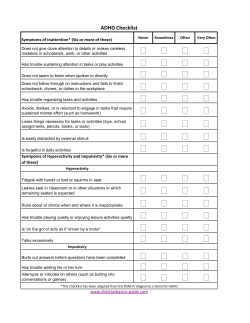
HOW TO PROCEED WITH TROUBLESHOOTING
IN−22 INTRODUCTION − HOW TO TROUBLESHOOT ECU CONTROLLED SYSTEMS HOW TO PROCEED WITH TROUBLESHOOTING IN04T−05 Carry out troubleshooting in accordance with the procedure on the following page. Here, only the basic procedure is shown. Details are provided in Diagnostics section, showing the most effective methods for each circuit. Confirm the troubleshooting procedures first for the relevant circuit before beginning troubleshooting of that circuit. Vehicle Brought to Workshop 1 2 1 Ask the customer about the conditions and the environment when the problem occurred. Customer Problem Analysis Symptom Confirmation and Diagnostic Trouble Code Check 3 Symptom Simulation 2, 3 Confirm the symptoms and the problem conditions, and check the diagnostic trouble codes. (When the problem symptoms do not appear during confirmation, use the symptom simulation method described later on.) 4 Diagnostic Trouble Code Chart 5 6 Problem Symptoms Table Circuit Inspection or Parts Inspection 7 Repair 8 Confirmation Test End LEXUS IS200 (RM684E) 4, 5, 6 Check the results obtained in Step 2, then confirm the inspection procedure for the system or the part which should be checked using the diagnostic trouble code chart or the problem symptoms table. 7 Check and repair the affected system or part in accordance with the instructions in Step 6. 8 After completing repairs, confirm that the problem has been eliminated. (If the problem is not reproduced, perform the confirmation test under the same conditions and in the same environment as when it occurred for the first time.) INTRODUCTION − HOW TO TROUBLESHOOT ECU CONTROLLED SYSTEMS IN−23 1. CUSTOMER PROBLEM ANALYSIS In troubleshooting, the problem symptoms must be confirmed accurately and all preconceptions must be cleared away in order to give an accurate judgment. To ascertain just what the problem symptoms are, it is extremely important to ask the customer about the problem and the conditions at the time it occurred. Important Point in the Problem Analysis: The following 5 items are important points in the problem analysis. Past problems which are thought to be unrelated and the repair history, etc. may also help in some cases, so as much information as possible should be gathered and its relationship with the problem symptoms should be correctly ascertained for reference in troubleshooting. A customer problem analysis table is provided in Diagnostics section for each system for your use. Important Points in the Customer Problem Analysis D What −−−−− Vehicle model, system name D When −−−−− Date, time, occurrence frequency D Where −−−−− Road conditions D Under what conditions? −−−−− Running conditions, driving conditions, weather conditions D How did it happen? −−−−− Problem symptoms (Sample) Engine control system check sheet. CUSTOMER PROBLEM ANALYSIS CHECK ENGINE CONTROL SYSTEM Check Sheet Inspector’s Name Model and Model Year Driver’s Name Frame No. Data Vehicle Brought in Engine Model License No. Odometer Reading Problem Symptoms Customer’s Name Engine does not Start Engine does not crank Difficult to Start Engine cranks slowly Other Poor Idling Incorrect first idle Idling rpm is abnormal Other Rough idling Poor Drive ability Hesitation Knocking Engine Stall Soon after starting After accelerator pedal depressed During A/C operation After accelerator pedal released Shifting from N to D Other Back fire Other No initial combustion High ( Muffler explosion (after−fire) Others Data Problem Constant LEXUS IS200 (RM684E) Sometimes ( times per day/month) km miles No complete combustion rpm) Low ( Surging rpm) IN−24 INTRODUCTION − HOW TO TROUBLESHOOT ECU CONTROLLED SYSTEMS 2. SYMPTOM CONFIRMATION AND DIAGNOSTIC TROUBLE CODE CHECK The diagnostic system in the LEXUS IS200 fulfills various functions. The first function is the Diagnostic Trouble Code Check in which a malfunction in the signal circuits to the ECU is stored in code in the ECU memory at the time of occurrence, to be output by the technician during troubleshooting. Another function is the Input Signal Check which checks if the signals from various switches are sent to the ECU correctly. By using these check functions, the problem areas can be narrowed down quickly and troubleshooting can be performed effectively. Diagnostic functions are incorporated in the following systems in the LEXUS IS200. System Engine Automatic Transmission ABS & Traction Control (TRC) System Supplemental Restraint System Theft Deterrent System Cruise Control System Engine Immobiliser System Combination Meter System Body Control System Multiplex Communication System LEXUS Navigation System Air Conditioning System Diagnostic Trouble Code Check Input Signal Check (Sensor Check) Diagnostic Test Mode (Active Test) f(with check Mode) f(with check Mode) f f f f f f f f f f f f f f f f f In diagnostic trouble code check, it is very important to determine whether the problem indicated by the diagnostic trouble code is still occurring or occurred in the past but returned to normal at present. In addition, it must be checked in the problem symptom check whether the malfunction indicated by the diagnostic trouble code is directly related to the problem symptom or not. For this reason, the diagnostic trouble codes should be checked before and after the symptom confirmation to determine the current conditions, as shown in the table below. If this is not done, it may, depending on the case, result in unnecessary troubleshooting for normally operating systems, thus making it more difficult to locate the problem, or in repairs not pertinent to the problem. Therefore, always follow the procedure in correct order and perform the diagnostic trouble code check. DIAGNOSTIC TROUBLE CODE CHECK PROCEDURE Diagnostic Trouble Code Check (Make a note of and then clear) Diagnostic Trouble Code Display Confirmation of Symptoms Diagnostic Trouble Code Check Problem symptoms Same diagnostic trouble code is exist displayed Normal code is displayed Normal Code Display LEXUS IS200 (RM684E) Problem Condition Problem is still occurring in the diagnostic circuit The problem is still occurring in a place other than in the diagnostic circuit (The diagnostic trouble code displayed first is either for a past problem or it is a secondary problem) No problem symptoms exist The problem occurred in the diagnostic circuit in the past Problem symptoms Normal code is exist displayed The problem is still occurring in a place other than in the diagnostic circuit No problem symptoms exist The problem occurred in a place other than in the diagnostic circuit in the past Normal code is displayed INTRODUCTION − HOW TO TROUBLESHOOT ECU CONTROLLED SYSTEMS IN−25 Taking into account the points on the previous page, a flow chart showing how to proceed with troubleshooting using the diagnostic trouble code check is shown below. This flow chart shows how to utilize the diagnostic trouble code check effectively, then by carefully checking the results, indicates how to proceed either to diagnostic trouble code troubleshooting or to troubleshooting of problem symptoms table. Diagnostic trouble code check Making a note of and clearing of the diagnostic trouble codes displayed Symptom confirmation Problem symptoms exist No problem symptoms exist Simulation test using the symptom simulation methods Diagnostic trouble code check D Diagnostic trouble code displayed D Problem symptoms exist D Normal code displayed D Problem symptoms exist Troubleshooting of problem indicated by diagnostic trouble code Troubleshooting of each problem symptom LEXUS IS200 (RM684E) D Normal code displayed D No problem symptoms exist System Normal If a diagnostic trouble code was displayed in the initial diagnostic tr ouble c ode c hec k , it indic ates that the trouble may have occurred in a wire harness or connector in that circuit in the past. Therefore, check the wire harness and connectors (See page IN−32). IN−26 INTRODUCTION − HOW TO TROUBLESHOOT ECU CONTROLLED SYSTEMS 3. SYMPTOM SIMULATION The most difficult case in troubleshooting is when there are no problem symptoms occurring. In such cases, a thorough customer problem analysis must be carried out, then simulate the same or similar conditions and environment in which the problem occurred in the customer’s vehicle. No matter how much experience a technician has, or how skilled he may be, if he proceeds to troubleshoot without confirming the problem symptoms he will tend to overlook something important in the repair operation and make a wrong guess somewhere, which will only lead to a standstill. For example, for a problem which only occurs when the engine is cold, or for a problem which occurs due to vibration caused by the road during driving, etc., the problem can never be determined so long as the symptoms are confirmed with the engine hot condition or the vehicle at a standstill. Since vibration, heat or water penetration (moisture) is likely cause for problem which is difficult to reproduce, the symptom simulation tests introduced here are effective measures in that the external causes are applied to the vehicle in a stopped condition. Important Points in the Symptom Simulation Test: In the symptom simulation test, the problem symptoms should of course be confirmed, but the problem area or parts must also be found out. To do this, narrow down the possible problem circuits according to the symptoms before starting this test and connect a tester beforehand. After that, carry out the symptom simulation test, judging whether the circuit being tested is defective or normal and also confirming the problem symptoms at the same time. Refer to the problem symptoms table for each system to narrow down the possible causes of the symptom. 1 VIBRATION METHOD: When vibration seems to be the major cause. CONNECTORS Slightly shake the connector vertically and horizontally. Shake Slightly WIRE HARNESS Slightly shake the wire harness vertically and horizontally. The connector joint, fulcrum of the vibration, and body through portion are the major areas to be checked thoroughly. Swing Slightly PARTS AND SENSOR Vibrate Slightly Apply slight vibration with a finger to the part of the sensor considered to be the problem cause and check that the malfunction occurs. HINT: Applying strong vibration to relays may result in open relays. V07268 LEXUS IS200 (RM684E) INTRODUCTION 2 − HOW TO TROUBLESHOOT ECU CONTROLLED SYSTEMS HEAT METHOD: When the problem seems to occur when the suspect area is heated. Heat the component that is the likely cause of the malfunction with a hair dryer or similar object. Check to see if the malfunction occurs. M a l f u n ction NOTICE: (1) Do not heat to more than 60 ˚C (140 ˚F). (Temperature is limited not to damage the components.) (2) Do not apply heat directly to parts in the ECU. 3 IN−27 WATER SPRINKLING METHOD: When the malfunction seems to occur on a rainy day or in a high−humidity condition. Sprinkle water onto the vehicle and check to see if the malfunction occurs. NOTICE: (1) Never sprinkle water directly into the engine compartment, but indirectly change the temperature and humidity by applying water spray onto the radiator front surface. (2) Never apply water directly onto the electronic components. HINT: If a vehicle is subject to water leakage, the leaked water may contaminate the ECU. When testing a vehicle with a water leakage problem, special caution must be taken. 4 OTHER: When a malfunction seems to occur when electrical load is excessive. Turn on all electrical loads including the heater blower, head lights, rear window defogger, etc. and check to see if the malfunction occurs. ON B02389 B02390 LEXUS IS200 (RM684E) IN−28 INTRODUCTION − HOW TO TROUBLESHOOT ECU CONTROLLED SYSTEMS 4. DIAGNOSTIC TROUBLE CODE CHART The inspection procedure is shown in the table below. This table permits efficient and accurate troubleshooting using the diagnostic trouble codes displayed in the diagnostic trouble code check. Proceed with troubleshooting in accordance with the inspection procedure given in the diagnostic chart corresponding to the diagnostic trouble codes displayed. The engine diagnostic trouble code chart is shown below as an example. D DTC No. Indicates the diagnostic trouble code. D Page or Instructions Indicates the page where the inspection procedure for each circuit is to be found, or gives instructions for checking and repairs. D Trouble Area Indicates the suspect area of the problem. D Detection Item Indicates the system of the problem or contents of the problem. DTC CHART (SAE Controlled) HINT: Parameters listed in the chart may not be exactly the same as your reading due to the type of instrument or other factors. If a malfunction code is displayed during the DTC check mode, check the circuit for that code listed in the table below. For details of each code, turn to the page referred to under the ”See page” for the respective ”DTC No.” in the DTC chart. DTC No. (See page) Detection Item Trouble Area P0100 (DI−24) Mass Air Flow Circuit Malfunction D Open or short in mass air flow meter circuit D Mass air flow meter D ECM P0101 (DI−28) Mass Air Flow Circuit Range/ Performance Problem D Mass air flow meter P0110 (DI−29) Intake Air Temp. Circuit Malfunction D Open or short in intake air temp. sensor circuit D Intake air temp. sensor D ECM P0115 (DI−33) Engine Coolant Temp. Circuit Malfunction D Open or short in engine coolant temp. sensor circuit D Engine coolant temp. sensor D ECM P0116 (DI−37) Engine Coolant Temp. CircuitRange/PerformanceProblem D Engine coolant temp. sensor D Cooling system Throttle/ Pedal Position Sensor/Switch ”A” Circuit Malfunction D Open or short in throttle position sensor circuit D Throttle position sensor D ECM Throttle/PedalPositionSensor/Switch ”A” Circuit Range / Performance Problem D Throttle position sensor LEXUS IS200 (RM684E) MIL* Memory INTRODUCTION − IN−29 HOW TO TROUBLESHOOT ECU CONTROLLED SYSTEMS 5. PROBLEM SYMPTOMS TABLE The suspected circuits or parts for each problem symptom are shown in the table below. Use this table to troubleshoot the problem when a ”Normal” code is displayed in the diagnostic trouble code check but the problem is still occurring. Numbers in the table indicate the inspection order in which the circuits or parts should be checked. HINT: When the problem is not detected by the diagnostic system even though the problem symptom is present, it is considered that the problem is occurring outside the detection range of the diagnostic system, or that the problem is occurring in a system other than the diagnostic system. D Page Indicates the page where the flow chart for each circuit is located. D Circuit Inspection, Inspection Order Indicates the circuit which needs to be checked for each problem symptom. Check in the order indicated by the numbers. D Problem Symptom D Circuit or Part Name Indicates the circuit or part which needs to be checked. PROBLEM SYMPTOMS TABLE Symptom Suspect Area See page Engine does not crank (Does not start) 1. Starter and starter relay ST−2 ST−17 No initial combustion (Does not start) 1. ECM power source circuit 2. Fuel pump control circuit 3. Engine control module (ECM) DI−147 DI−151 IN−29 No complete combustion (Does not start) 1. Fuel pump control circuit DI−151 Engine cranks normally (Difficult to start) 1. Starter signal circuit 2. Fuel pump control circuit 3. Compression DI−144 DI−151 EM−3 Cold engine (Difficult to start) 1. Starter signal circuit 2. Fuel pump control circuit DI−144 DI−151 Hot engine 1. Starter signal circuit 2. Fuel pump control circuit DI−144 DI−151 High engine idle speed (Poor idling) 1. A/C signal circuit (Compressor circuit) 2. ECM power source circuit AC−88 idling) 1. A/C signal circuit 2. Fuel pump control circuit 1. Compression 2. Fuel pump control circuit LEXUS IS200 (RM684E) IN−30 INTRODUCTION − HOW TO TROUBLESHOOT ECU CONTROLLED SYSTEMS 6. CIRCUIT INSPECTION How to read and use each page is shown below. D Diagnostic Trouble Code No. and Detection Item D Circuit Description The major role and operation, etc. of the circuit and its component parts are explained. DTC P0325 Knock Sensor 1 Circuit Malfunction CIRCUIT DESCRIPTION Knock sensor is fitted to the cylinder block to detect engine knocking. This sensor contains a piezoelectric element which generates a voltage when it becomes deformed, which occurs when the cylinder block vibrates due to knocking. If engine knocking occurs, ignition timing is retarded to suppress it. DTC No. P0325 DTC Detecting Condition Trouble Area No knock sensor 1 signal to ECM with engine speed, 1,200 rpm or more. D Open or short in knock sensor1 circuit D Knock sensor 1 (looseness) D ECM If the ECM detects the above diagnosis conditions, it operates the fall safe function in which the corrective retard angle value is set to the maximum value. D Indicates the diagnostic trouble code, diagnostic trouble code set parameter and suspect area of the problem. WIRING DIAGRAM ECM Knock Sensor 1 GR 12 KNK E6 E1 D Wiring Diagram This shows a wiring diagram of the circuit. Use this diagram together with ELECTRICAL WIRING DIAGRAM to thoroughly understand the circuit. Wire colors are indicated by an alphabetical code. B = Black, L = Blue, R = Red, BR = Brown, LG = Light Green, V = Violet, G = Green, O = Orange, W = White, GR = Gray, P = Pink, Y = Yellow, SB = Sky Blue The first letter indicates the basic wire color and the second letter indicates the color of the stripe. V08423 LEXUS IS200 (RM684E) INTRODUCTION − HOW TO TROUBLESHOOT ECU CONTROLLED SYSTEMS D Indicates the position of the ignition switch during the check. ON LOCK Ignition Switch ON Ignition Switch LOCK (OFF) START ACC Ignition Switch ACC Ignition Switch START IN−31 D Inspection Procedure Use the inspection procedure to determine if the circuit is normal or abnormal, and, if it is abnormal, use it to determine whether the problem is located in the sensors, actuators, wire harness or ECU. INSPECTION PROCEDURE 1 Check continuity between terminal KNK of ECM connector and body ground. PREPARATION: (a) Remove the glove compartment (See page SF−68). (b) Disconnect the E6 connector of ECM. LOCK KNK CHECK: Measure resistance between terminal KNK of ECM connector and body ground. E6 Connector OK: Resistance: 1 MW or higher AB0117 A00265 A00255 OK Go to step 3. NG 2 Check knock sensor (See page SF−61). OK Replace knock sensor. D Indicates the place to check the voltage or resistance. D Indicates the connector position to be checked, from the front or back side. Wire Harness Check from the connector back side. (with harness) Check from the connector front side. (without harness) In this case, care must be taken not to bend the terminals. D Indicates the condition of the connector of ECU during the check. KNK E6 Connector Connector being checked is connected. KNK E6 Connector Connector being checked is disconnected. V08425 LEXUS IS200 (RM684E)
© Copyright 2025














